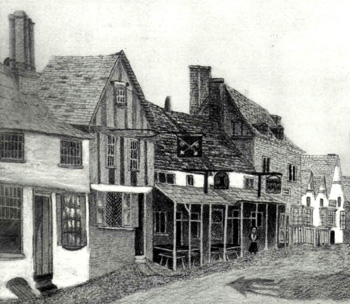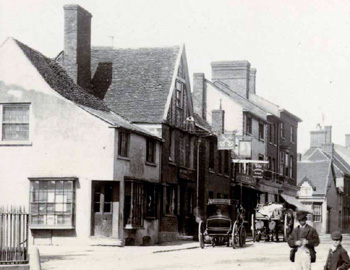The Boot Public House Leighton Buzzard

The Cross Keys, Boot and Curriers Arms in 1798 [Z50/72/38]
The Boot Public House: 33 and 33b Market Square, Leighton Buzzard
The Manor of Leighton Buzzard alias Grovebury was the principal landowner in the town before the 19th century. Bedfordshire & Luton Archives & Records Service has a full run of court rolls from 1393 to 1727 [KK619-715] and another full run from 1704 to 1867 [X288/1-23]. The service also has court rolls for other manor to own land in the town, the Prebendal Manor, from 1448 to 1459, 1588 to 1591, 1611 to 1622, 1627 and 1631 [KK792-1798]. Detailed study of these would be bound to produce quite full histories for most licensed premises in the town. Unfortunately such study would take a very long time. Thus the histories of licensed premises in these web pages are quite summary and not necessarily the full story.
The Boot public house stood in what was known as Middle Row in the Market Square, in between the Cross Keys and the Curriers Arms. The first mention seems to be in 1720 when the Boot was clearly already in business and may have been trading for some time, further research, as outlined above, being necessary to determine for how long. In 1720 the copyhold inn was surrendered by William Whipham junior and Ann, his wife, to Arthur Mathews of London, gentleman, and Letitia, his wife [X288/3]. Mathews was buying up a number of inns around the town, such as the Unicorn and the Maidenhead around this time. When he died in 1746 he devised the Boot and other premises to local Justice of the Peace John Salusbury [X288/5].
In 1960 Bedfordshire Historical Records Society published a volume, its fortieth, dedicated to diaries. County Archivist Joyce Godber edited and published Salusbury's diary written between the years 1757 and 1759. Oddly he does not mention the Boot as he does the other inns he owned and frequented, so perhaps he sold it. Certainly in 1790 (Salusbury died in 1787) the Boot was owned by Arthur Clarke as he surrendered it in that year to Daniel Parker [X288/9].
In the Northampton Mercury of 19th January 1793 licensee of the Boot, William Drage subscribed to a resolution of Leighton Buzzard publicans banning "seditious and disaffected persons" from their houses. This presumably was in reaction to the events across the Channel in France (four days previously King Louis XVI had been sentenced to death and two days later he went to the guillotine).
By 1835 the Boot was owned by Dunstable brewer Thomas Burr (not to be confused with the more famous Luton Burrs, who ran a brewery in that town); when he died in that year he devised the Boot, along with other licensed premises elsewhere, to trustees [BH407]. In 1840 the Boot was conveyed by the trustees to Edward Burr and he mortgaged them the following year. Edward Burr put up his Dunstable Brewery for sale by auction in 1843, the Boot being described as follows [BH409]: "containing Parlor [sic] with Cellar under, Bar, Tap, and two Bed Rooms. Wash-house with Pump of Water therein, and Stable for three horses, opening into the Back Street, with a newly brick-built and slated Market Room over, approached by a separate Staircase, and a small Loft". Reference to the Back Lane is interesting; this ran, basically, along the same course as today's West Street. If the Boot's stables opened onto Back Street they were obviously some distance from the inn, which was always a small establishment - unless the phrase Back Lane is here taken to mean that part of the Market Square (usually called Eagle Street at this date) running into North Street.
The brewery was not sold as a complete piece and the Boot seems to have been bought by Woburn brewer James Fowler, as he was admitted to the establishment at a manorial court in 1845 [BO482]. Fowler's brewery was sold by auction in 1881 [WL1000/10/1/1] and the Boot was purchased by Aylesbury [Buckinghamshire] brewers Parrott and Walker.

The Cross Keys, Boot and Curriers Arms about 1895 [Z1306/72]
On 8th March 1899 there was a disastrous fire at the next door Cross Keys, the Luton News for the 9th March reported: "Both the adjoining houses, the "Boot", and Mr. King's hairdresser's shop, were in danger of being destroyed, and as it was the former received considerable damage before the fire was got under, but the furniture in this case was nearly all saved. The building of the Cross Keys is a complete wreck and the "Boot" has sustained a good deal of damage". Both the Cross Keys and the Boot were completely rebuilt, as is clear from comparing the drawing at the head of this page with the one below; the neighbouring Curriers Arms seems to have escaped the fire. This is the modern 31 Market Square and seems to also show how the Boot looked before 1899.

33 Market Square (on the left) in June 2008
By 1903 the Boot was owned by the Aylesbury Brewery Company which sold the public house by auction in 1903. The sale particulars [BML10/42/115] describe the Boot as comprising:
- a basement cellar;
- on the ground floor: a passage; a bar measuring 9 feet by 14 feet; a tap room measuring 21 feet 3 inches by 7 feet 9 inches; a kitchen measuring 11 feet 3 inches by 12 feet fitted with a range and sink and with water laid on; a scullery with a grate and copper; a W.C. and a coal store;
- on the first floor: three bedrooms and, approached by a separate flight of stairs, a large club room measuring 22 feet by 14 feet 9 inches.
The particulars stated that there were entrances from the Market Square and from Eagle Street and that the property had a frontage of 21 feet to the Market Place and 25 feet to Eagle Street, the maximum depth being 44 feet. This indicates that the public house comprised both the modern 33 and 33b Market square at the rear. It was sold to P. H. Read for £360 and its licence was terminated on 2nd February 1904 and transferred to the Stag, in Heath Road, which had previously been just a beerhouse.

Plan of 33 Market Square in the valuer's notebook
Under the terms of the Rating and Valuation Act 1925 every piece of land and building in the country was assessed to determine the rates to be paid on them. Leighton Buzzard was assessed in 1927 and the valuer visiting the former Boot noted [DV1/R74/56] that it was then owned and occupied by Charles Lamport. A tobacconist shop occupied the former bar, there was also a sweet shop measuring 10 feet 6 inches by 22 feet (perhaps part of the former tap room) and a café measuring 21 feet by 15 feet (clearly in the old club room) which was "very little used". He also noted a W.C., a room measuring 12 feet by 16 feet, a kitchen measuring 16 feet by 15 feet and a basement under the shop. The dimensions of the rooms clearly differ from those of the 1903 sale particulars (except for the tobacconists in the former bar) showing that significant internal alterations had taken place.
Four years earlier the Leighton Buzzard Observer (3rd July 1923) had written of the old public house as follows:"When the old Cross Keys Inn was burned down in 1899 the Fire Brigade were firecely criticised by a whimsical townsman, firstly for "turning out too promptly" and secondly "for doing their work too well". The Middle Row, he always declared, ought to be swept away and a good fire - which the Brigade had completely spoilt - was the only way to get it done. It has been shown recently, however, that even some of the older buildings in Middle Row may be brought into line with modern ideas of comfort and convenience without losing any of their quaintness. The premises of the old "Boot" Inn, are a case in point. Since Mr. Lamport purchased these premises they have been gradually remodelled, and today no longer bear any resemblance to the buildings to be seen in the old prints of Market Square. The latest development is the conversion of the upper floor into a delightful cafe, and it is a pleasure to record that the work has been done by a local builder, Mr. A. E. Sear. In the course of the work thirty loads of bricks and rubble had been taken from the chimney stack and an old charred beam was found. Middle Row is apparently not to meet the fiery fate assigned to it in 1899; Mr. Lamport is endeavouring to show - and apparently very successfully - that it is worthy of better things".
References:
- X288/3: surrender: 1720;
- X288/5: death of Arthur Matthews: 1746;
- X288/5: admission of John Salusbury: 1746;
- X288/9: surrender: 1790;
- Northampton Mercury: resolution of Leighton Buzzard publicans banning "seditious and disaffected persons" from their houses: 19 Jan 1793;
- CLP13: Register of alehouse licences: 1822-1828;
- BH407: will of Thomas Burr: proved 1835;
- BH407: conveyance: 1840;
- BH407: abstract of Mortgage: 1841;
- BH409 and X95/17: sale catalogue of Dunstable Brewery: 1843;
- BO482: admission of James Fowler: 1845;
- PSLB4/1: Register of Alehouse Licences - Leighton Buzzard Petty Sessional Division: c.1860s-1949;
- PSLB4/3: Register of Alehouse Licences - Leighton Buzzard Petty Sessional Division: c.1860s-1956;
- WL1000/10/1/1: auction sale particulars of brewery in Woburn and 26 public houses formerly of James Fowler of Woburn, brewer: 1881;
- RY1073: will of William Charles Dimmock: 1894, proved 1898;
- P91/28/48: indicated as having been at 33 Market Square in notes compiled on Leighton Buzzard public houses: early 20th century;
- BML10/42/323: valuation of Boot: 1903;
- BML10/42/115: sale particulars of Boot: 1903;
- DV1/R74/56: valued for rates: 1927
List of Licensees: note that this is not a complete list; entries in italics refer to licensees where either beginning or end, or both, dates are not known:
1720: Daniel Oldnoll;
1746: Martha Oldnoll;
1788-1790: William Heathcote;
1793 -1830: William Drage;
1843-1847: Henry Gandy;
1850-1864: Charlotte Gandy
1869: George Smith
1871-76: Charlotte Smith;
1877-1881: Alfred Cook;
1881-1882: Joseph Smith;
1882-1883: Jeffery Archer;
1883: Charles Price;
1898: William Charles Dimmock;
1898-1899: Bessie Dimmock;
1899: Joseph Hutchins;
1899-1900: William George Barr;
1900-1901: Richard Stephenson;
1901: Edward Thacker;
1901-1902: George Watkins;
1902-1903: Edwin Pamfleet;
1903-1904: Alfred George Kentish
Public house closed 2nd February 1904 and full license transferred to Stag